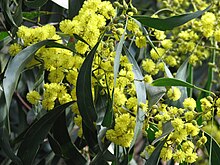| Acacia s.l. | |
|---|---|

| |
| Senegalia greggii (syn. A. greggii) | |
| Scientific classification | |
| Kingdom: | Plantae |
| Clade: | Tracheophytes |
| Clade: | Angiosperms |
| Clade: | Eudicots |
| Clade: | Rosids |
| Order: | Fabales |
| Family: | Fabaceae |
| Subfamily: | Caesalpinioideae |
| Clade: | Mimosoid clade |
| Genus: | Acacia Mill.[1] |
| Type species | |
| Acacia nilotica (until 2005) Acacia penninervis (post 2005) | |
| Species | |
|
About 1,300; see list of Acacia species | |
Acacia s.l. (pronounced ⫽əˈkeɪʃə⫽ or ⫽əˈkeɪsiə⫽), known commonly as mimosa, acacia, thorntree or wattle,[2] is a polyphyletic genus of shrubs and trees belonging to the subfamily Mimosoideae of the family Fabaceae. It was described by the Swedish botanist Carl Linnaeus in 1773 based on the African species Acacia nilotica. Many non-Australian species tend to be thorny, whereas the majority of Australian acacias are not. All species are pod-bearing, with sap and leaves often bearing large amounts of tannins and condensed tannins that historically found use as pharmaceuticals and preservatives.
The genus Acacia constitutes, in its traditional circumspection, the second largest genus in Fabaceae[3] (Astragalus being the largest), with roughly 1,300 species, about 960 of them native to Australia, with the remainder spread around the tropical to warm-temperate regions of both hemispheres, including Europe, Africa, southern Asia, and the Americas (see List of Acacia species). The genus was divided into five separate genera under the tribe "Acacieae". The genus now called Acacia represents the majority of the Australian species and a few native to southeast Asia, Réunion, and Pacific Islands. Most of the species outside Australia, and a small number of Australian species, are classified into Vachellia and Senegalia. The two final genera, Acaciella and Mariosousa, each contain about a dozen species from the Americas (but see "Classification" below for the ongoing debate concerning their taxonomy).



- ^ Genus: Acacia Mill. – Germplasm Resources Information Network (GRIN)
- ^ Carruthers, Jane; Robin, Libby (February 2010). "Taxonomic imperialism in the battles for Acacia: Identity and science in South Africa and Australia". Transactions of the Royal Society of South Africa. 65 (1): 48–64. Bibcode:2010TRSSA..65...48C. doi:10.1080/00359191003652066. S2CID 83630585.
- ^ Thiele, Kevin R.; Fnk, Vicki A.; Iwatsuki, Kunio; Morat, Philippe; Peng, Ching-I; Raven, Peter; Sarukhán, José; Seberg, Ole (February 2011). "The controversy over the retypification of Acacia Mill. with an Australian type: A pragmatic view" (PDF). Taxon. 60 (1): 194–198. doi:10.1002/tax.601017. ISSN 0040-0262. Archived (PDF) from the original on 2022-10-09. Retrieved 6 November 2015.
